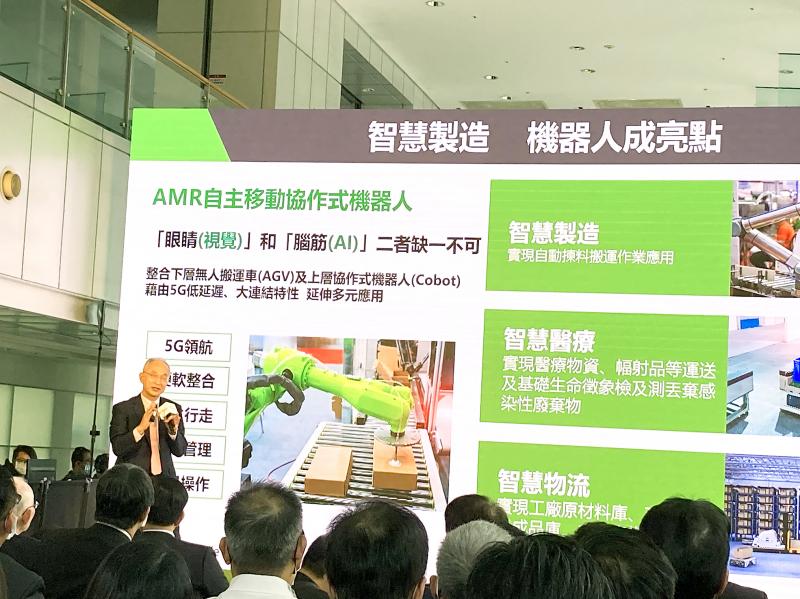Asia Pacific Telecom Co (APT, 亞太電信) yesterday said it aims to turn a profit in the next three to five years by boosting revenue contribution from enterprise customers, which deliver better margins and are keen to adopt ultrahigh-speed and low-latency 5G services.
APT made the remarks after launching its 5G services on 3.5-gigahertz and millimeter-wave on the 28-gigahertz band, with the latter better suited to building private networks for local enterprises.
APT, 40 percent owned by Hon Hai Precision Industry Co (鴻海精密), is the sole domestic telecom to secure a spectrum license to build 5G networks on 28-gigahertz band.

Photo: Lisa Wang, Taipei Times
The telecom depends heavily on retail consumers to generate revenue, who account for 70 percent of its base, while enterprise customers make up just 30 percent, company president Huang Nan-ren (黃南仁) told a media briefing in Taipei.
With more 5G applications coming on-line, APT aims to boost enterprise customers’ contribution to half of its revenue within the next three to five years, Huang said.
“Enterprise customers deliver better margins and would help narrow our losses,” Huang said.
It is the company’s goal to reduce its losses by between NT$500 million and NT$1 billion (US$17.3 million and US$34.6 million) a year, he said.
APT has also set an internal target to convert 10 to 12 percent of its 4G subscribers to 5G services within the first year of their launch, Huang said.
The company saw losses widen to NT$2.9 billion in the first half of this year, from a loss of NT$2.6 billion in the same period last year.
As part of its turnaround efforts, APT yesterday unveiled its 5G tariffs, ranging from NT$599 to a flat rate starting at NT$1,399 a month, similar to the offerings by the nation’s big three telecoms.
It was a marked difference from its previous strategy of undercutting the competition to attract price-sensitive users.
“The prices reflect our improvement on Internet connection quality, as well as our brand equity,” Huang said. “Our marketing team will adjust our pricing strategy according to the market situation. Pricing will be dynamic.”
Huang dismissed speculation that APT is under pressure from Far EasTone Telecommunications Co (遠傳電信) to raise 5G tariffs as it is leasing the company’s 3.5G-band spectrum.
Far EasTone last month said that it planned to acquire an 11.58 percent stake in APT for NT$5 billion at the most, in the first phase of its broader plan to deepen their partnership to trim heavy 5G deployment costs via spectrum sharing.
The deal would give APT much-needed access to Far EasTone’s 3.5G 5G spectrum for 20 years.
APT also agreed to pay an extra NT$9.47 billion for using the spectrum, as well as sharing about 22 percent of the network deployment costs.
The company added that it plans to raise NT$17.5 billion through private placements.
Hon Hai is expected to invest NT$10 billion and Far EasTone to invest NT$5 billion, APT said, with the remainder coming from its 5G supply chain, the company said.

Among the rows of vibrators, rubber torsos and leather harnesses at a Chinese sex toys exhibition in Shanghai this weekend, the beginnings of an artificial intelligence (AI)-driven shift in the industry quietly pulsed. China manufactures about 70 percent of the world’s sex toys, most of it the “hardware” on display at the fair — whether that be technicolor tentacled dildos or hyper-realistic personalized silicone dolls. Yet smart toys have been rising in popularity for some time. Many major European and US brands already offer tech-enhanced products that can enable long-distance love, monitor well-being and even bring people one step closer to

Malaysia’s leader yesterday announced plans to build a massive semiconductor design park, aiming to boost the Southeast Asian nation’s role in the global chip industry. A prominent player in the semiconductor industry for decades, Malaysia accounts for an estimated 13 percent of global back-end manufacturing, according to German tech giant Bosch. Now it wants to go beyond production and emerge as a chip design powerhouse too, Malaysian Prime Minister Anwar Ibrahim said. “I am pleased to announce the largest IC (integrated circuit) Design Park in Southeast Asia, that will house world-class anchor tenants and collaborate with global companies such as Arm [Holdings PLC],”

TRANSFORMATION: Taiwan is now home to the largest Google hardware research and development center outside of the US, thanks to the nation’s economic policies President Tsai Ing-wen (蔡英文) yesterday attended an event marking the opening of Google’s second hardware research and development (R&D) office in Taiwan, which was held at New Taipei City’s Banciao District (板橋). This signals Taiwan’s transformation into the world’s largest Google hardware research and development center outside of the US, validating the nation’s economic policy in the past eight years, she said. The “five plus two” innovative industries policy, “six core strategic industries” initiative and infrastructure projects have grown the national industry and established resilient supply chains that withstood the COVID-19 pandemic, Tsai said. Taiwan has improved investment conditions of the domestic economy

Sales in the retail, and food and beverage sectors last month continued to rise, increasing 0.7 percent and 13.6 percent respectively from a year earlier, setting record highs for the month of March, the Ministry of Economic Affairs said yesterday. Sales in the wholesale sector also grew last month by 4.6 annually, mainly due to the business opportunities for emerging applications related to artificial intelligence (AI) and high-performance computing technologies, the ministry said in a report. The ministry forecast that retail, and food and beverage sales this month would retain their growth momentum as the former would benefit from Tomb Sweeping Day